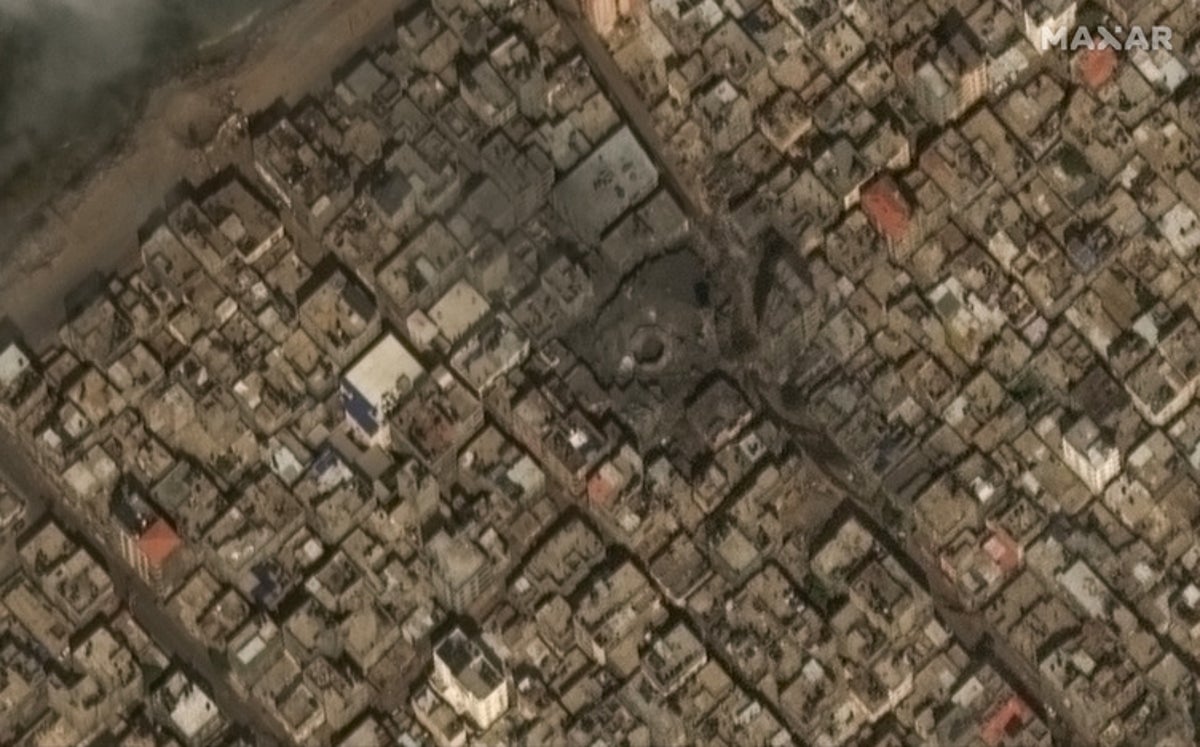Satellite images show deadly destruction of Gaza


Dramatic aerial images of Gaza shows the extent of damage caused by deadly Israeli airstrikes, that have caused terror and devastation across the region.
Residential buildings, markets and mosques have been destroyed in retaliation for the attack launched by Hamasterrorists on Israel’s territories on Saturday.
The Gaza energy authority has warned that they only have “only 10 to 12 hours of fuel left”, while hospitals are said to be “at capacity” with thousands injured and awaiting treatment.
Aerial image shows an airstrike over the Gaza Strip
(Maxar )
Following the attack upon its citizens by Hamas, Israel has announced a “complete siege” and has cut off water, food, fuel and electricity supplies to the region, which is home to 2.3 million people.
One image taken by Maxar shows smoke rising above buildings in Gaza, which has so far killed at least 950 people, with more than 2,700 wounded.
Follow our live blog for all the latest updates
Israeli military officials have warned that they have “created an iron wall of tanks, helicopters and aircraft” around the enclave, with airstrikes continuing for the fourth day.
Meanwhile, Palestinian authorities have accused Israel of targeting the “entire neighbourhood” around the Al-Sousi mosque, which was razed to the ground by an airstrike on Monday. .
A view over Gaza City in August, before the latest conflict erupted with Israel
(Copyright 2023 The Associated Press. All rights reserved.)
The mosque is located inside Gaza City’s Shati refugee camp, with three other mosques targeted in the area, with its population running low on medicine and food.
Dozens of Palestinians are said to have been killed in the camp, with images showing survivors clambering over rubble and piling bodies onto stretchers.
The Al Sousi mosque in Gaza City’s Shati refugee camp has been completely destroyed
(Maxar )
Palestinians seen inspecting the damage at the Al-Sousi mosque
(AFP via Getty Images)
Gaza City’s Yassin mosque has also been destroyed in an airstrike, with satellite imagery showing the structure’s dome to be obliterated.
The Rimal neighbourhood has also suffered deadly bombardments, with residential buildings and shops destroyed, with rescue officials reporting that “large numbers” of people were still trapped under the rubble.
A number of residential buildings have been destroyed with at least 900 Palestinians killed
(Maxar )
The Israeli military said it had struck undreds of targets in Rimal, which is home to universities, media organisations and ministries of the Hamas government, who first gained control of the Gaza Strip in 2007.
The latest conflict has now claimed the lives of nearly 2,000 people, with Israel’s prime minister Benjamin Netanyahu stating on Monday that their bombardment of Gaza had “only started”.
It began after an unprecedented attack by Hamas militants on Saturday morning, which saw armed groups open fire on Israeli civilians and launch rockets towards major cities including Tel Aviv.
Smoke rises above Watan Tower after it was destroyed in an aerial bombardment
(Maxar)
Families were killed in their own homes, while gunmen killed 260 partygoers at a festival near the border before taking an estimated 100 people hostage.
Following aerial bombardments, Abu Ubaida, a spokesperson for the armed section of Hamas, said that they would begin to execute civilian hostages if innocent civilians are targeted.
As well as the siege, Israel have also called up 300,000 of its reservists, with Netanyahu warning: “What we will do to our enemies in the coming days will reverberate with them for generations.”
United Nations Secretary-General Antonio Guterres later said he was “deeply distressed” by Israel’s decision to impose the siege, while the UN are attempting to accommodate 200,000 refugees in Gaza.
xnxx,
xvideos,
porn,
porn,
xnxx,
Phim sex,
mp3 download,
sex 4K,
Straka Pga,
gay teen porn,
Hentai haven,
free Hentai,
xnxx,
xvideos,
porn,
porn,
xnxx,
Phim sex,
mp3 download,
sex 4K,
Straka Pga,
gay teen porn,
Hentai haven,
free Hentai,




